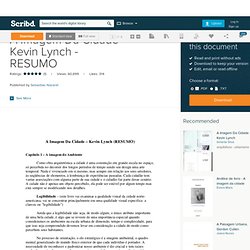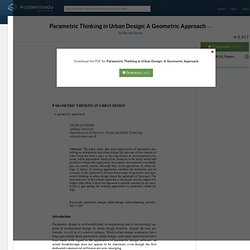

The Genetic Algorithm in Architecture. DIGITAL_ARCH. A Imagem Da Cidade - Kevin Lynch - RESUMO. Cada imagem individual é única e possui algum conteúdo que nunca ouraramente é comunicado, mas ainda assim ela se aproxima da imagem pública que, emambientes diferentes, é mais ou menos impositiva, mais ou menos abrangente.Oconteúdo das cidades até aqui estudadas, que remetem às formas físicas , pode seradequadamente classificado em 5 tipos de elementos: vias, limites, bairros, pontosnodais e marcos e podem ser definidos da seguinte maneira:1- Vias – são canais de circulação ao longo dos quais o observador se locomove demodo habitual, ocasional ou potencial.

Podem ser ruas, alamedas, linhas detrânsito, canais, ferrovias. Para muitas pessoas, são estes elementospredominantes em sua imagem.2- Limites - são elementos lineares não usados ou entendidos como vias peloobservador, são fronteiras entre duas faces, quebras de continuidade lineares:praias, margens de rios, lagos, etc., cortes de ferrovias, construções, muros eparedes. São referências laterais, mais que eixos coordenados3- Parametric Thinking in Urban Design: A Geometric Approach (Nicolai Steinø)
In a recent article, Tim Love (2009) divides the adoption of parametricdesign to architectural and urban design into two strands.

At the one end of the spectrum, parametric design tools are used for “gee-whiz form-making”,while at the other, the same technology facilitates “a metric-based emphasison social and/or ecological relevance” (ibid.). While contending that the twoopposites often appear alongside each other, he is critical of both. On the onehand, the form-making approach seems to mask a lack of genuine form-making competency through complex forms generated from data of inscru-table origin, while on the other, what seems to be a concern for the envi-ronment is too often a veil of chastity over designs which are merely explor-ations of form:
02002-02029 (27 years): By 2029 no computer - or &machine intelligence& - will have passed the Turing Test. - Long Bets - StumbleUpon. The Significance of the Turing Test.

The implicit, and in my view brilliant, insight in Turing's eponymous test is the ability of written human language to represent human-level thinking. The basis of the Turing test is that if the human Turing test judge is competent, then an entity requires human-level intelligence in order to pass the test. The human judge is free to probe each candidate with regard to their understanding of basic human knowledge, current events, aspects of the candidate's personal history and experiences, as well as their subjective experiences, all expressed through written language. As humans jump from one concept and one domain to the next, it is possible to quickly touch upon all human knowledge, on all aspects of human, well, humanness. There are many contemporary examples of computers passing "narrow" forms of the Turing test, that is, demonstrating human-level intelligence in specific domains. Why I Think I Will Win. NeoArchaic Design.
[Architecture eBook] the Dissertation - An Architecture Student's Handbook. The Digital Studio » Architecture Master Thesis ARCT1051 – Dissertation. Dissertation Path Course Code: ARCT 1051Coordinator: Dr Marko JobstLevel: 7Credit: 60Dissertation Supervisors: Dr Marko Jobst, Dr Teresa Stoppani; H&T staff Introduction The Architecture Master Thesis develops a critical understanding of contemporary architecture and the relevant cultural debates.

Architecture is explored as an act of thinking, drawing, writing, inhabiting, making and challenging space. It provides students with the opportunity to carry out academic research on their chosen subject, and to develop arguments relating to it. The course is introduced by a series of support courses: Critical Thinking; Research Methods; Design and Research Issues; Reading Seminars; Influences, Theories & Techniques in Architecture. Throughout the course, exchanges with other schools within and outside the University are encouraged, as are publication of work and presentation at conferences and seminars. Learning Outcomes By the end of the course the student will be able to: Course Structure Theory. I.M.A.D.E. AA Emtech. IINNPPUUTT. Parametric design. Experimentacion y software. Generative design. PARAMETRIC ARCHITECTURE.